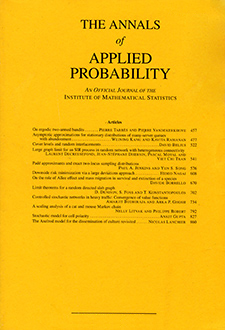Abstract
In this paper we investigate the structure of the equilibriumstate of three-dimensional catalytic super-Brownian motion where the catalyst is itself a classical super-Brownian motion.We show that the reactant has an infinite local biodiversity or genetic abundance. This contrasts to the finite local biodiversity of the equilibriumof classical super-Brownian motion. Another question we address is that of extinction of the reactant in finite time or in the long-time limit in dimensions $d = 2,3$. Here we assume that the catalyst starts in the Lebesgue measure and the reactant starts in a finite measure.We show that there is extinction in the long-time limit if $d = 2 or 3$. There is, however, no finite time extinction if $d = 3$ (for $d = 2$, this problem is left open).This complements a result of Dawson and Fleischmann for $d = 1$ and again contrasts the behaviour of classical super-Brownian motion. As a key tool for both problems, we show that in $d = 3$ the reactant matter propagates everywhere in space immediately.
Citation
Klaus Fleischmann. Achim Klenke. "The biodiversity of catalytic super-Brownian motion." Ann. Appl. Probab. 10 (4) 1121 - 1136, November 2000. https://doi.org/10.1214/aoap/1019487609
Information





